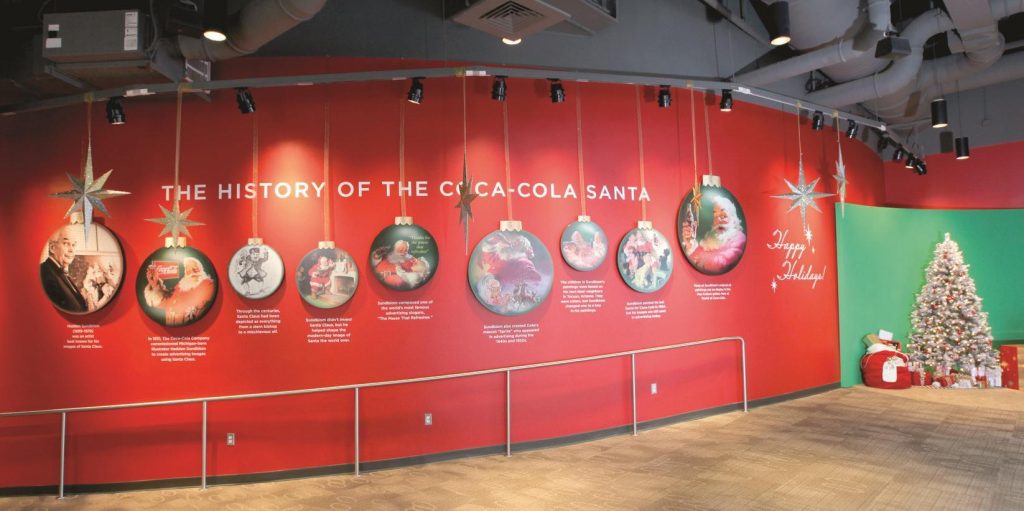
The History of Santa & Coca-Cola

The Santa Claus we all know and love—that big, jolly man in the red suit with a white beard—didn’t always look the way he does today. In fact, Santa’s appearance has evolved over centuries. It has been shaped by folklore, literature, and a clever marketing campaign from one of the world’s most recognizable brands: Coca-Cola. This is the story of how Santa and Coca-Cola became forever linked in popular imagination. Their connection helped to define the modern image of Christmas.
Santa’s Image
Before Coca-Cola entered the picture, Santa’s image varied dramatically. He was portrayed as everything from a tall, gaunt man to a spooky-looking elf. In the 19th century, Thomas Nast, a political cartoonist during the Civil War, sketched Santa for Harper’s Weekly as a small, elfish figure who supported the Union. Over the 30 years he illustrated Santa, Nast gradually changed the character’s look. He eventually dressed him in a red suit—a detail that would later become central to his identity.
Coca-Cola’s connection to Santa began in the 1920s, when the company started using Santa in magazine ads such as The Saturday Evening Post. These early Santas were based on Nast’s strict, traditional depictions. Then, in 1930, artist Fred Mizen painted a department-store Santa enjoying a Coke among holiday shoppers. This image was used in holiday advertising and marked the beginning of something new.
Santa and Coca-Cola Team Up Begins
But it was in 1931 that Coca-Cola truly transformed Santa into the figure we know today. The company wanted to create a wholesome, approachable version of Santa who was both realistic and symbolic. They sought someone who could appear in ads but also feel like the Santa children imagined. Therefore, they turned to Haddon Sundblom, a Michigan-born illustrator, to bring this vision to life. He drew inspiration from Clement Clarke Moore’s 1822 poem A Visit from St. Nicholas (commonly known as ’Twas the Night Before Christmas). Sundblom painted a Santa who was warm, plump, rosy-cheeked, and full of joy. He was a Santa who laughed, played with toys, read letters, and—of course—enjoyed Coca-Cola.
Sundblom’s Santa debuted in The Saturday Evening Post in 1931 and quickly became a beloved holiday fixture. His artwork appeared in numerous publications, including National Geographic, Ladies Home Journal, and The New Yorker. From 1931 to 1964, Coca-Cola’s ads showed Santa pausing for a Coke, raiding refrigerators, and visiting wide-eyed children. The original oil paintings were adapted for everything from billboards and store displays to calendars and holiday merchandise. Many of these items are prized collectibles today.
Who Was Santa?
Sundblom originally modeled his Santa after his friend, Lou Prentiss, a retired salesman. After Prentiss passed away, Sundblom used himself as the model, painting while looking into a mirror. In later years, he completed his work using photographs. He added personal touches to every detail in the artwork—he based the children on his neighbors and transformed a florist’s gray poodle into a black dog in the 1964 painting to make it stand out. Fans noticed even the smallest changes. When Sundblom painted Santa’s belt backward or omitted his wedding ring, Coca-Cola fans wrote to the company with concern. Their response showed how deeply people connected with this version of Santa.

In 1942, Coca-Cola added a new holiday character: Sprite Boy. He was an elf-like figure who accompanied Santa in ads throughout the ’40s and ’50s. Despite his name, Sprite Boy was unrelated to the now-famous soft drink Sprite. Interestingly, this drink wouldn’t debut until the 1960s. In 2001, Coca-Cola gave its Santa new life through animation. They based a TV commercial on Sundblom’s 1963 artwork. The ad was brought to life by Academy Award-winning animator Alexandre Petrov.
Coca-Cola & Santa Now
Today, the Coca-Cola Santa is more than a piece of advertising—he’s an icon. While Coca-Cola didn’t invent Santa’s red suit, they undeniably helped standardize and globalize the image of Santa Claus. He became a symbol of joy, kindness, and nostalgia. Through the warm brushstrokes of Haddon Sundblom and the reach of Coca-Cola’s marketing, Santa became a timeless emblem of Christmas cheer.

Every holiday season, as those familiar red-and-white images reappear, we’re reminded of how art, tradition, and commerce blended to shape the magic of Christmas. Thanks to Coca-Cola, Santa Claus will forever be more than just a storybook figure—he’ll be a symbol of celebration, generosity, and holiday spirit.




